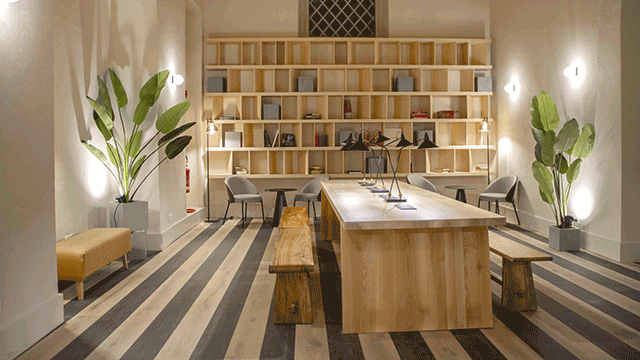by Michael Foster
Apart from his extraordinarily curly hair, the thing which tends to impress people in the property world about Irvine Sellar is his energy.
In the last year alone, he has finished putting his private UK property company, backed by Gerald Ronson, into the quoted group which has become Ford Sellar Morris. FSM has gone on to buy 10 department stores from House of Fraser, snapped up Centrovincial Estates and expanded its own development programme.
With partner Mel Morris, Sellar also has substantial private interests in the States. In the UK, they are both backers to clothes retailer Amber Day, and their little investment club has just put money into a shell company called West Industries.
FSM is now selling big chunks of the Fraser and Centrovincial portfolios. Centrovincial’s 8 1/2-acre towncentre shopping site in Worcester, with a potential completed value of £80m, has just been put on the block. The only thing which irritates Sellar these days is his share price, which, at 98p, he considers quite outrageously cheap.
Sellar is a tough cookie with a sense of humour, whose manner is vaguely reminiscent of John Elliott of Australia combine Elders IXL. He is coy about details of his past life, though cross-examination does reveal that he used to be a trader in Carnaby Street during the swinging sixties.
From 1965, he built up the Irvine Sellar and Mates fashion chains, which had 70 outlets when he sold to a South African concern in 1981. The chains have now been broken up. “I think the South Africans had exchange control problems,” says Sellar.
In 1982, he stumbled across Mel Morris, who ran Jean Junction in the 1970s. They pooled their skills to form a company eventually consolidated as Sellar Morris Developments, which went into partnership with Gerald Ronson’s Heron Corporation.
SMD found sites: Ronson helped to provide interim finance for developments before resale to institutions, and everyone was happy. Heron typically took a quarter of the profits from joint schemes and SMD gained extra credibility for its skills with retail property.
The big schemes which SMD tackled in Britain included the refurbishment of a 135,000-sq ft Binns department store in Liverpool; a 25,000-sq ft shop and office project in Harrow; and a 50,000-sq ft shopping centre in Hounslow.
With the encouragement of Gerald Ronson, the duo also went to America. Their biggest scheme to date is the 106-acre Vista Centre next to Disney World in Florida, earmarked for shops, a hotel, and leisure and residential units.
Part of their interest in Vista was injected into ESM, which has now taken profits to leave the rest in the hands of Morris, Sellar and their private partners. The duo own six other sites in various parts of the United States, and Sellar does not rule out injecting the operation into FSM when it has matured.
In the year to April 1984, SMD made pre-tax profits of £42,000 (after notional directors’ remuneration) on gross property sales of £3.73m. By 1986-87, the total had risen to £820,000 on £26.9m.
It was in the mid-1980s that Sellar and Morris noted potential in the quoted downmarket ladies’ fashion chain Martin Ford. Established in Tooting in 1925 as a seller of handbags and gloves, Ford later diversified into clothes. It wandered on to the stock market in 1971 through an offer for sale valuing the company at £5.5m.
Before too long, Ford’s shares developed a humdrum rating, only occasionally enlivened as the odd operator spotted potential in its property. Ford brought in designers from Terence Contran’s studios to ginger up it shops, but by the mid-1980s they were making heavy losses.
Arnold Ziff’s Town Centre Securities built up a 5% stake in Ford, despite the fact that the Ford family held 57% of the shares and showed little intention of selling. Ziff’s patience was rewarded in early 1986 when the Ford family responded to various approaches by putting control of the company up for sale.
Sellar says: “We went to merchant bank Singer & Friedlander and told them we’d finance a deal if they could find a retailer. They couldn’t find a retailer, so we found one.”
To do the deal, Sellar and Morris teamed up with Jeffrey and Nicholas Wallis, whose Wallis fashion chain was bought by Sears in 1980. Their Iridium investment group bought 32% of Ford for £3.5m and placed the rest of the Ford family’s stake with institutions.
The new Ford board, including the Wallis family, was chaired by company doctor Ronnie Aitken who tried and failed to save Ron Shuck’s Espley Trust in the early 1980s. It was in power by July, and decided to sell various properties to Heron’s subsidiary, Interland, for £7.6m. The proceeds were used to rename and revamp the Ford chain into “Stage”, designed to cater for younger women.
Ford also bought the Barrie menswear chain with a key Oxford Street trading unit for £1.15m and appointed William Johnston (formerly with the C & J Clark shoe company) as executive director.
“I had an open mind about the retail business,” says Sellar. “It wasn’t a bad ticket to have. But we eventually decided it would be better for Ford to be a property company.” He and Mel Morris joined the Ford board in November 1986.
In effect, Sellar and Morris decided to put their own property interests into Ford rather than act as venture capitalists. Ford sold the Stage operation to Lee Cooper for £5.59m in March 1987. It bought a small menswear chain called Take 6 soon after as a logical add-on to Barrie, which could increase its potential resale value under the trading name, Review.
Barrie has now been sold to Amber Day for £5.53m. Once a loss-making ladies’ retailer, Amber Day was taken over by Irvine Sellar, Jeffrey Wallis and Nicholas Wallis in mid-1987. It then built up a 5% stake in the troubled Cecil Gee fashion operation, landing a fat profit when Moss Bros made a takeover bid. Profits at Amber Day are rising fast. Its Barrie purchase has boosted its interests, allowing FSM to concentrate purely on property.
In mid-1987, rumours started circulating that Ford would buy Sellar Morris Developments. Excited by the knowledge that Gerald Ronson was an SMD backer, the market pushed Ford’s shares to 238p before they were suspended in August 1987 so the deal could be done.
Terms were soon worked out by which SMD was injected into Ford for 9m shares at 100p each. Ford also acquired six retail investments from Heron (developed through the SMD-Heron partnership) for £5.2m in shares, cash and convertible loan stock. Heron agreed to retain a million shares and committed itself to a five-year financing deal with Ford worth £30m.
At the time, SMD pointed out that as a partnership it had handled sales of developments worth £75m since starting. It had 17 projects on the go, and promised to make profits of £2m in the year to April 1988.
Though its ambitions were enormous, the book net worth of SMD was small. Tony Leyland from SMD, who used to work for construction-cum-property group Rush & Tompkins, became managing director of the revitalised Ford under Irvine Sellar, chairman and chief executive.
On coming back to the market, Martin Ford shares spiralled to new highs of 251p. “It was great while it lasted,” sighs Irvine Sellar, regretting that the October stock market crash put paid to his hopes of exchanging them at a high price for solid assets.
From this 1987 peak Ford’s shares were humbled to 75p in November, even though it announced a cut in losses for the interim period to August from £1.14m to £206,000. Pundits envisaged a bounce back from losses of £2.2m in the 14 months to January 1987; FSM achieved £3.5m in the 15 months to April. “A £6m turnaround,” says Sellar, with pride.
Not content with all the effort involved in reconstructing Martin Ford (soon renamed Ford Sellar Morris), Irvine Sellar and his team were busy in the second half of 1987 negotiating the possible purchase of a group of 10 department stores from House of Fraser, owned by the Al Fayed family.
These negotiations followed FSM’s unsuccessful attempt to buy three other Fraser stores in the teeth of a counter-offer from Nick Sivitier’s Hardanger Properties. The talks turned out to be extremely long-winded.
It was not until last May that House of Fraser signed the deal. FSM paid £6.5m for its interests in the 10 stores, totalling 240,000 sq ft, with vacant possession promised for August. FSM has since spent more money to buy in other interests. “We took X and added Y and Z to the properties,” says Sellar. “The deals have not been straightforward.” His willingness to tackle complicated deals like this is particularly impressive.
Sellar confirms that he now expects to sell nine of the 10 stores. Two have already gone; another five are in the solicitors’ hands for reletting or reselling.
The one store which FSM aims to redevelop is in Newton Abbot. Currently 45,000 sq ft, the acquisition of adjoining land should make a 100,000-sq ft shopping scheme feasible. Sellar expects to put in a planning application within two weeks.
FSM’s purchase of Centrovincial Estates in March was a much quicker affair. It began early this year when Sellar was reviewing the possibility of buying some assets out of the company.
Centrovincial was founded by Joe Gold, who sold it to Nigel Wray’s Gilbert House shell company in April 1987. Wray went on to inject merchant bank Singer & Friedlander into Gilbert House, and sold six of Centrovincial’s properties for £26m to Sam Rosen and Nick Leslau’s Burford Properties just before the 1987 stock market crash.
By early 1988, day-to-day management of the group had passed from Nigel Wray to S&F boss Tony Solomons. After talks about individual property sales S&F gave Sellar the chance to buy the whole of Centrovincial, provided he could wrap up the deal within seven days.
Sellar’s team did well to meet the deadline. They agreed to pay £44.6m for the company, £12m of which came from the issue of 14.5m shares at 83p per share. Barclays de Zoete Wedd placed these with institutions, and the balance of £32.6m in cash was borrowed from Bankers Trust.
The deal left FSM with gearing of more than 250% heaped on net assets of £16.8m. Rents receivable from Centrovincial did not cover interest charges resulting from the deal, and FSM agreed a rapid programme of disposals with its bankers.
It has now sold £30m of property; the buyers were mainly dealers prepared to take a view on rent reviews and relettings which Sellar did not want to hang around for. A further £5m of property could be knocked out, including assets in South Africa. Sellar has yet to make up his mind about some land owned by Centrovincial in Miami, Florida.
The Centrovinical buildings he is retaining are a mixture of cash cows and prospective developments. The biggest, with an estimated value of more than £10m, is the 220,000-sq ft Leon House in Croydon, which has Tate & Lyle and Brooke Bond as headlessors, and some 30 other tenants, including Mitsubishi. The current rent boils down to £7 per sq ft, with £12 possible on review, given that new buildings in Croydon are getting £20. There is scope to provide an extra 50,000 sq ft of offices and improve 15,000 sq ft of shops underneath.
FSM will work to maximise income from Leon House by making it suitable for 24-hour occupation (something which appeals to Japanese tenants) and carrying out a rolling refurbishment. It is also working to improve a fully tenanted block in Twickenham, Middx called Regal House, whose 140,000 sq ft are let at around £8 per sq ft and deserve £15.
One tip-top potential redevelopment is at the 19,000-sq ft Melrose House in Savile Row, SW1, subject to agreement with tenants. Two other medium-sized West End buildings are suitable for refurbishment or redevelopment. An old Airfix factory in Charlton will be turned into retail warehousing and industrial space.
The jewel in Centrovincial’s development portfolio is the central Worcester shopping site, which involves a 300,000-sq ft redevelopment of the old Blackfriars centre. Beatties is a key store tenant; others are rumoured to be C&A and Marks & Spencer.
“It’s too bad that we can’t keep the scheme,” says Sellar. “But it would unbalance the company. I don’t particularly want us to be known as ‘That company with a big scheme in Worcester’, though I would be pleased to be there if we were bigger.”
Sellar will only do a deal which has the full approval of the local authority.
He expects to forward fund the scheme on such a basis that he will be able to account for profits over a period of three years, though an all-out sale is possible.
FSM also has an impressive range of other developments in its £250m programme. They include a DIY superstore in Aberdare; a site outside Bury which should be home to an Asda superstore; and a 12-screen cinema operated by Warner which Sellar reckons will be the largest in Europe; a prospective 115,000-sq ft of non-food retailing in Hedge End, Hampshire; and a retail warehouse in Norwich.
Other big schemes are in Llanelli, Livingston and Chester-Le-Street; while a part interest in 27 acres at Frog Hall Farm in Coventry has given FSM an income stream from excavation and tipping rights.
FSM’s developments have typically been forward funded. Its schemes will continue to have a retail bias, though Sellar is now looking more actively at other sectors.
He is more confident than some stockbrokers that demand for retail space will remain firm, though he is afraid that some developers are paying too much for their sites: “We’ve just pulled out of two or three schemes because we don’t want to overpay,” he says. “Our job as developers is to offer retailers space at the right price. There is a danger that by over-valuing sites certain developers will try to squeeze the retailers too hard.”
FSM’s rent roll is now £3.5m, though development and other sales will still provide the backbone to group profits in the immediate future.
In April, net assets were £21.5m, gross assets were £104m and net borrowings £47m.
Borrowings are now estimated to be down to £40m, and gross assets £110m. Sellar is looking at various institutional portfolios on the market for between £20m and £40m. He has employed a former chief surveyor of National Provident called Robert Hacking-Brian to help him get the very best by moving in the right circles.
Friendly brokers think that pre-tax profits this year could be £11m, indicating that the shares, at 98p; are on an earnings multiple of five. Current trends indicate that FSM might have net assets per share of between 120p and 150p by next April.
Irvine Sellar is frustrated over the City’s reluctance to give his shares a better rating. He believes he has put 101% of his effort into giving FSM an asset backing, plus an income stream, which should answer the sternest of his critics.










